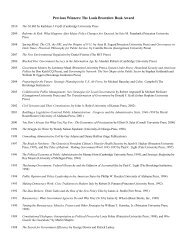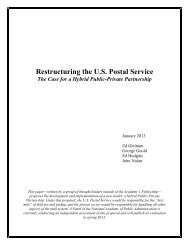High-Performance Partnerships - National Academy of Public ...
High-Performance Partnerships - National Academy of Public ...
High-Performance Partnerships - National Academy of Public ...
You also want an ePaper? Increase the reach of your titles
YUMPU automatically turns print PDFs into web optimized ePapers that Google loves.
Challenges<br />
NBSD encountered some barriers at the outset.<br />
Citizens initially were skeptical <strong>of</strong> the partnership,<br />
viewing it as just another short-term program.<br />
NBSD also had some difficulty creating<br />
equality among the partners so that public and<br />
civic sectors could share responsibility and<br />
accountability for results. The capacity and<br />
continuity <strong>of</strong> neighborhood leadership proved<br />
challenging, as well.<br />
Over time, NBSD has addressed many <strong>of</strong> these<br />
issues. Developing trust among the partners<br />
has been key. The city has convinced neighborhoods<br />
that its commitment is genuine and<br />
long term. NBSD is not really a program but a<br />
Neighborhood Based Service Delivery has resulted in<br />
the growth <strong>of</strong> neighborhood associations throughout<br />
Des Moines. Originally, only distressed neighborhoods<br />
with strong leaders were identified for the partnership.<br />
Within a year or two, dozens <strong>of</strong> associations wanted to<br />
be included. Now, they have been formed in wealthier,<br />
more stable parts <strong>of</strong> town. The general citizenry understands<br />
that partnerships work, and the city benefits<br />
from having citizens engaged in problem solving in their<br />
own neighborhoods.<br />
Connie Cook, Neighborhood Based Service Delivery (Des Moines)<br />
way <strong>of</strong> doing business, and Des Moines has<br />
made a concerted effort to institutionalize this<br />
problem-solving approach. Committed citizen<br />
leadership was influential in engaging residents<br />
who do not normally participate.<br />
Keys to Success<br />
Civic and public leaders cite several factors as<br />
contributing to NBSD’s success. Strong city<br />
and neighborhood leadership has been critical.<br />
Also, powerful symbols illustrate the initiative’s<br />
impact. Neighborhoods are physically improving<br />
through better property maintenance and<br />
decreased criminal activity. The partnership’s<br />
loose organizational structure is considered a<br />
strength as it allows flexibility. A strong dedication<br />
to the mission keeps partners in sync.<br />
NBSD is focused on problem solving and<br />
results, not meetings and committees.<br />
Also key is an understanding that the public<br />
and civic sectors are held jointly accountable<br />
for results. This notion has helped to frame<br />
expectations for the partners involved. Citizens<br />
know their role is to help solve problems, not<br />
just identify them. Conversely, the city understands<br />
that it must respond to the citizens’ priorities<br />
and treat each neighborhood uniquely.<br />
As NBSD matures, it grapples with how to<br />
define and quantify outcomes. A more formalized<br />
evaluation process is being developed. The<br />
continuity <strong>of</strong> neighborhood leadership also<br />
remains an ongoing issue. Reviewing their<br />
progress to date, partners <strong>of</strong>fer several key lessons:<br />
establish leadership training early; delegate<br />
decision-making to the lowest possible<br />
level; be willing and able to adapt; establish clear<br />
expectations in the beginning; and start small,<br />
achieve some successes, then grow to scale.<br />
55 Powering the Future: <strong>High</strong>-<strong>Performance</strong> <strong>Partnerships</strong>









